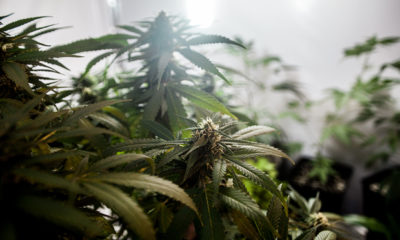
Economics
Canada Pot Stocks Dipped After Last Quarter Before Legal Sales
Numbers are affected by buyouts and upscaling.
Financial results for the third quarter of 2018 in Canada’s cannabis market are in and some of the country’s biggest industry players missed the mark on summer expectations.
At the top of the list are Canopy Growth, Aurora Cannabis, and Tilray. In what may seem like a wacky statistic, Aurora’s stock dipped 15 percent to $6.15 despite the fact its sales were up 333 percent from a year ago as Barron’s noted. Canopy and Tilray both saw their stocks dip 10 percent on the day.
Part of the reasons behind those numbers is buyouts and scaling up. All three of these companies are spending big money to get their hands on the biggest chunk of the pie possible. Aurora said it hopes to be up to producing 1.2 million pounds of cannabis a year by 2020 on a call with investors this week.
Canopy CEO Bruce Linton appeared on CNBC this week where he was asked to explain the revenue decline through the quarter ending in September.
“Canada ended prohibition on October 17th, and a lot of our patients wondered what was going to go on and if they would go to a store and buy recreationally. But also there was a little slow down on Germany, it was more about a process of getting approvals,” Linton told CNBC, he himself sold the first legal purchase in the country braving hurricane force winds to make it happen.
Linton took the blame for the stock dip as analysts work to build a model to say how much companies will actually sell now with prohibition over. And the actual start of that post-prohibition dataset won’t likely get to the rest of us until March next year.
CNBC asked how things are going in the current quarter and if they were seeing more buying.
“People seem to like cannabis,” Linton said. “And when it’s sanctioned by the government and federally legal we are shipping a lot of cannabis. What we’re having to do is not just ship dry bud, but people, we’re actually trying to move them to the Canadian version of the gummy bear, which is a gelcap.”
Next Linton was hit with Canopy’s 54 percent out of stock rate and asked what was being done to scale up.
“We shipped product and it got bought. As the reason it got bought… they were lined up around the block and the lineup kept going. So what we’ve been doing is we just keep filling more and more orders,” he said.
Linton noted of all the product in stock in Canada, about 30 percent of it was Canopy. He wants to see that number go up. Linton said he is looking at everything in six-month sprints. The current spring is filling the market. The first half of 2019 will be developing a wide range of products, “who knows that an edible will be,” he said.
“And then the final six-month sprint is going to be who has the best branded most desired products and owns the market,” he said.
Linton said the world is changing. He pointed to Malaysia’s recent move to get the ball rolling on medical cannabis.
“I fell off my chair,” he said of the changes in Malaysia. “Because that means every corner of the world is changing and if we do it right in Canada we can fill it in.”
Next Linton got hit with a question on how much more expensive Canopy products were by the gram and if it could hold up. He said it was a function of form factor. He compared it to selling raw sugar cane compared to people who put in finished goods that get sold for a premium.
South of the border, longtime industry expert Kris Krane of 4Front Advisors has been keeping an eye on Canada for a while. He gave Cannabis Now his take on the dip that came on news of the earning reports.
“I think a course correction was somewhat inevitable,” Krane told Cannabis Now. “The valuations never made a lot of sense compared to the earnings, the actual performance. It’s all based on hype and speculation and eventually, these things need to be measured more by actual execution and performance.”
Krane isn’t sure if the dip is even cannabis specific also. The problems corporate cannabis are facing could be attached to general market decline.
We asked Krane what he thought the rebound would look like in a few months when the first hard numbers from legalizations impact on the marketplace come in.
“I don’t know because legalization was already factored into the price [the companies were being valued at],” he said. “I wouldn’t expect to see a massive jump because that’s the reason the prices were so high, to begin with. They’re already accounting for legalization. It’s already baked in.”
Krane expects somewhat of a rebound but doesn’t know if we’ll see a massive jump.
Krane closed by giving his take on whether there was another industry right now where a company like Aurora can report a 333 percent sales to jump from its year-ago quarter and still slip more than 15 percent?
“No, of course not, it’s like the early internet.” he said. “Public markets are basing this whatever they want to base it on, not actual metrics. That’s going to lead to a lot of volatility. I don’t think there is anything out there right now that’s even remotely comparable.”
TELL US, do you have any cannabis stocks?
























